


NOTE: many of the urls referenced in this newsletter are no longer active.
In January 1997, CLRC was delighted to play host to the World Wide Web Consortium (W3C) for their meeting at Rutherford Appleton Laboratory (RAL) at which seventy companies were present from all over the world. CLRC has been a W3C member from the beginning and Prof Bob Hopgood from the Department for Computation and Information (DCI) co-ordinated the meeting held at RAL.
W3C was created in 1994 to develop common standards for the evolution of the World Wide Web (web). It is an international industry Consortium jointly hosted by the Massachusetts Institute of Technology Laboratory for Computer Science (MIT/LCS) in the United States, the Institut National de Recherche en Informatique et en Automatique (INRIA) in Europe; and the Keio University Shonan Fujisawa Campus in Asia. It is led by Tim Berners-Lee, the creator of the web and Director of the W3C. The Chairman is Jean-Francois Abramatic from MIT. It is vendor neutral, working with the global community to produce specifications and reference software that is made freely available throughout the world.
The main business of the meeting was to present recent work by the W3C staff. Important recent developments discussed were the new version of HTML (version 3.2), now agreed. Version 1.1 of the http protocol is being evaluated and offers significantly better transport times and is far more 'network friendly' than the previous version. Version 1.1 has the 'style sheets' mechanism which allows the presentation of document elements to be specified separately from the document itself, thus allowing web pages to be given a corporate style.
The progress achieved in the areas of digital signatures on documents, electronic payment schemes and page content selection mechanisms was also covered. A major thrust of all the developments is towards 'open interworking', allowing new technologies to be introduced with minimal impact on other web users.
At a Reception in the RAL Exhibition area, DCI's David Boyd gave a demonstration of the work of his Group carried out in conjunction with W3C on Computer Graphics Metafile (CGM) and Virtual Reality Modelling Language (VRML).
Tim Berners-Lee received at W3C the Institute of Physics' (IoP) prestigious Duddell Medal and Prize for his outstanding contribution to the advancement of knowledge by the invention of the networked information system, the web. The presentation was made by Godfrey Stafford, former President of the IoP and previous winner of the IoP's Glazebrook Prize and Medal (1981).
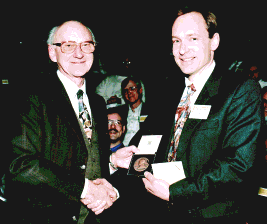
A dinner was held at the magnificent Oxford University Museum which was built in 1860 and houses the University's scientific collections accumulated since the 1600s. Tim Berners-Lee and Robert Cailliau advised Dr Brian Atkins, the Curator of Minerals, on how the Museum's web site might be improved!
More information about W3C on http://www.w3.org/pub/WWW/. More information about DCI on http://www.dci.clrc.ac.uk
Virtual Reality (VR) is a powerful technology for solving today's real world problems. The Advanced Interactive Systems Group (AISG) in the Department for Computation and Information (DCI) is helping scientists and engineers to exploit VR in the development of the next generation of major science and engineering projects at Rutherford Appleton Laboratory (RAL). Using VR, we are able to investigate the detailed design of engineering systems before they are built, to plan work in hazardous physical environments and to explore the analytical world of complex scientific data.
From its early prominence in the entertainment business, VR has now matured into an important tool for serious technical applications. By bringing together high performance real time computer graphics, the latest interactive devices such as head-mounted displays, position trackers, stereo projection and 3D input devices, and object- oriented software designed to model the behaviour of the real world, VR can provide the user with a powerfully engaging feeling of 'being there'. In these computer generated virtual environments, users interact with objects which look and behave realistically and examine information displayed in new ways. This provides the opportunity for a greater understanding of problems and the potential for new insights into possible solutions.
This article describes some of the projects currently underway or planned using VR at CLRC.
CLRC is collaborating with CERN to develop the Atlas End Cap Toroid (AECT), part of the Atlas detector being built for the Large Hadron Collider (LHC) at CERN, Europe's Nuclear Research Centre near Geneva. The LHC is due to be completed around 2005 and will be the largest particle accelerator in the world. The AECT system contains an array of superconducting magnets producing a toroidal magnetic field round the intersecting accelerator beams. The design and construction of AECT is a very large, complex and technologically challenging engineering project.
AISG's VR experts have been working closely with the AECT project engineers to develop a VR model of their design. The engineers initially created a design for AECT using RAL's Computervision CAD system. The CAD data was then transferred into the VR environment where a VR expert constructed an interactive, animated VR model of AECT using Division's dVS VR software. Particular care had to be taken to adjust the complexity of the VR model to preserve the necessary engineering detail while making it perform as quickly as possible. The engineers then interactively examined this VR model using a stereo projection system and a head-mounted display. As a result, they were able to improve their design and to decide on their proposed assembly sequence for constructing the actual detector when all the parts have been built and brought together at CERN. The VR model has also proved to be an excellent vehicle for communicating the design and assembly information to engineers working on the project at other European laboratories and to the physicists who will ultimately be carrying out experiments using the Atlas detector.
A short video of the assembly sequence has been produced from the VR animation and the VR model has been translated into the Virtual Reality Modelling Language (VRML) so it can be accessed using the World Wide Web (web). The project is also stimulating developments within the VR system itself including virtual instruments for making measurements and for interacting with the model.
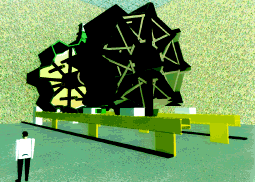
Figure 1 shows the assembled superconducting magnet system in the foreground about to move into the cryostat vessel in the background. The 'human' figure gives an impression of the scale of the system.
MAPS is a new neutron scattering detector system being planned for the ISIS Spallation Neutron Source at RAL. Its shape is sufficiently complex that it was difficult to confirm the correctness of its design using only a CAD system. The design was transferred into the VR system and an interactive model created showing all the parts of the design in their correct relative positions, including the incoming neutron beam line and the arrays of detectors which measure the neutrons scattered by the target. Using this VR model, the engineers could view the MAPS system from many angles, including from inside the vacuum vessel, and check whether the geometrical arrangement of the design was correct. This then led to further design improvements and developments.
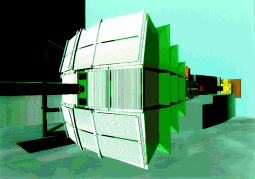
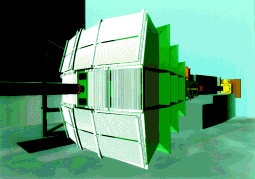
Figures 2 and 3 show views of the MAPS detector with the neutron beamline emerging from the blue ISIS Target Station. The detector arrays are shown in white on the curved end face of the green vacuum vessel.
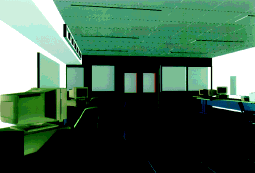
VR can be a useful tool for planning the interior spaces of buildings and for enabling potential visitors to become familiar with the operation of an environment before visiting it. As a simple example, Figure 4 shows the inside of one of the computer rooms in the Atlas Centre modelled using 3D Studio and converted into an interactive model using the VR system.
VR models of real environments are also useful for planning operations such as maintenance tasks in hazardous locations. An example at CLRC is changing components inside the ISIS accelerator during shut-downs. Working out the sequence of steps in advance to minimise operator exposure to radiation is of great importance. Another potential application of VR is helping to train the scientists who must visit RAL to carry out their experiments but who are unfamiliar with the appearance and functionality of the experimental equipment before they arrive. By having a VR model of the experiment available on the web using VRML, remote users could familiarise themselves with it before they arrived at RAL thus saving time and money during their visit.
Existing scientific visualization systems provide a wide range of useful functions for looking at complex data and for presenting it in helpful ways. However, their presentation on a 2D screen limits the interactivity which the user can have with the data. By coupling the functionality of a visualization system with the real time 3D interactivity of VR, new power can be placed in the hands of researchers for examining their data. This is currently an active area of development within AISG and one which we feel holds much promise for the future. Being able to look 'inside' the data and control its presentation from this vantage point will provide research scientists with exciting new possibilities.
To support its growing programme in VR, DCI now has a powerful VR Facility centred around an 8-processor Silicon Graphics Onyx system with 3 Reality Engine graphics pipelines driving a variety of stereo output devices. The main software in use is Division's dVS system but other tools including VRML are also available. The VR Facility is closely coupled to other graphics, visualization and digital media facilities run by AISG enabling video output onto tape or in MPEG-encoded form onto CD-ROM or the web. We have good network connections and are investigating the possibility of remote working for users unable to visit the Facility. The Advanced Interactive Systems Group is keen to collaborate with scientists and engineers who feel that these facilities could be useful to them in their research.
Networks and data communication are a pervasive part of our daily life from banks to supermarket checkouts; travel agents to holiday reservations; commerce to industry. Indeed CLRC is reliant upon computer networks for its business; from delivering its Scientific Programmes to its customers, to providing the means for the necessary administrative support of its business.
Today much is written and spoken of the Internet and plans, by the G7 Nations, are well advanced to create a Global Information Infrastructure. This initiative is required to work for all sectors of industry. It must support interactive and multimedia applications and allow an individual to share, use and manage information anytime and anywhere at an acceptable level of cost, quality, security and privacy. This goal can only be delivered if agreements are reached at the technical level across the World, and this means that Network Standards are a prerequisite of these developments.
Many organisations set Standards for networking and data communications but all are founded upon a common vision which meet particular needs in the marketplace.
The International Organization for Standardization (ISO) is a federation of national standards bodies from some 100 countries which has as its aims the development of standardised activities to facilitate the international exchange of goods and services, and to develop cooperation in the spheres of intellectual, scientific, technological and economic activity.
The International Telecommunications Union (ITU) is an international organisation within which governments and the private sector coordinate, develop, regulate and standardise networks and services. The original SRCnet and Janet networks were built using protocols and procedures defined by this organisation. More recently they were responsible for the definition of the ATM technology which has been extended by the ATM Forum.
The Internet Society is a non-governmental international organisation for global cooperation and coordination of the Internet and its internetworking technologies and applications. Its technical work is carried out by the Internet Engineering Task Force (IETF) which comprises an international community of network designers, operators, vendors, and researchers. The existing Internet, including the Janet network, makes use of TCP/IP and its associated protocols developed by the IETF.
The Institute of Electrical and Electronic Engineers sponsors the LAN/MAN Standards Committee, also known as IEEE 802, which develops standards for Local and Metropolitan Area Networks. The CLRC networking infrastructure is built using technologies developed under the auspices of this organisation and includes ethernet, token ring, bridges and switches. The CLRC Network Group has been closely involved with these organisations over the years and has established itself as a centre of excellence in many significant technical areas. It was involved in many of the wide area routing and addressing developments with ISO; made significant technical contributions to the development of LAN bridges within IEEE 802; it continues to Chair the UK committee responsible for LAN and MAN developments; and represents the UK on these matters at ISO Plenary meetings.
In addition the Group is closely involved with the new developments of Virtual LANs and multimedia extensions to LANs within IEEE 802; and it is represented within the IETF with particular reference to Network Management and more generally with the new IPv6 (IP Next Generation (IPng)) developments.
There are many complexities in this fast moving area and the Group's involvement at the specification stage alongside the major manufacturers has consistently given it an edge when designing and developing the CLRC network. When networks operate correctly users are unaware of their presence!
More information see: http://www.iso.ch, http://www.itu.int, http://www.atmforum.com/, http://info.isoc.org/index.html, http://www.ieee.org/, or contact R.Tasker@dl.ac.uk or P.S.Kummer@dl.ac.uk